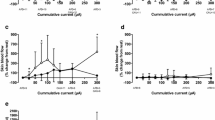Abstract
The aim of the present study was to compare the cutaneous postischaemic hyperaemic response in young insulin-dependent diabetic patients and healthy subjects during normoglycaemia, acute insulin-induced hypoglycaemia and in the posthypoglycaemic state. After a night of normoglycaemia the cutaneous postischaemic hyperaemic response in the forearm skin, measured by the transcutaneousPO 2 method, was the same in both groups. A reduction of the maximal postischaemic vasodilatory response was observed in diabetic patients from 2.4±0.3 to 2.0±0.2 kPa (P<0.05) and in control subjects from 2.7±0.3 to 1.8±0.2 kPa (P<0.02) during insulin-induced hypoglycaemia (plasma glucose<2 mmol/l). Complete recovery of the vasodilatory response occurred in subjects in the posthypoglycaemic state. We conclude that hypoglycaemia induced a transient reduction of the vasodilatory response, which was rapidly reversed after glucose counter-regulation, in both diabetic patients and healthy controls. Thus, the prevailing blood glucose concentration must be taken into account when the postischaemic vasodilatory response is investigated in diabetic patients.
Similar content being viewed by others
References
Ditzel J, Functional microangiopathy in diabetes mellitus. Diabetes 17: 388–397, 1968
Altura BM, Halevy S, Turlapaty PDMV, Vascular smooth muscle in diabetes and its influence on the reactivity of blood vesels. In: Davis E (ed) The microcirculation in diabetes. Karger, Basel, pp 118–150, 1979
Ewald U, Tuvemo T, Rooth G, Early reduction of vascular reactivity in diabetic children detected by transcutaneous oxygen electrode. Lancet I: 1287–1288, 1981
Ewald U, Tuvemo T, Reduced vascular reactivity in diabetic children and its relation to diabetic control. Acta Paediatr Scand 74: 77–84, 1985
Railton R, Newman P, Hislop J, Harrower ADB, Reduced transcutaneous oxygen tension and impaired vascular response in type 1 (insulin dependent) diabetes. Diabetologia 25: 340–342, 1983
Jörgensen RG, Russo L, Mattioli L, More WV, Early detection of vascular dysfunction in type 1 diabetes. Diabetes 37: 292–296, 1988
Shore AC, Price KJ, Sandeman DD, Green EM, Tripp JH, Tooke JE, Impaired microvascular hyperemic response in children with diabetes mellitus. Diabetic Med 8: 619–623, 1991
Katz MA, McNeil G, Defective vasodilation response to exercise in cutaneous precapillary vessels in diabetic humans. Diabetes 36: 1386–1396, 1987
Rayman G, Williams SA, Spencer PD, Smaje LH, Wise PH, Tooke JE, Impaired microvascular hyperaemic response to minor skin trauma in type I diabetes. BMJ 292: 1295–1298, 1986
Tymms DJ, Tooke JE, The effect of continuous subcutaneous insulin infusion (CSII) on microvascular blood flow in diabetes mellitus. Int J Microcirc Clin Exp 7: 347–356, 1988
Hilsted J, Bonde-Petersen F, Nørgaard MB, Greniman M, Christensen NJ, Parving H-H, Suzuki M, Haemodynamic changes in insulin-induced hypoglycaemia in normal man. Diabetologia 26: 328–332, 1984
Åman J, Berne C, Ewald U, Tuvemo T, Lack of cutaneous hyperemia in response to insulin-induced hypoglycemia in IDDM. Diabetes Care 13: 1029–1033, 1990
Åman J, Berne C, Ewald U, Tuvemo T, Cutaneous blood flow during a hypoglycaemic clamp in insulin-dependent diabetic patient and healthy controls. Clin Sci 82: 615–618, 1992
Heding LG, Radioimmunological determination of human C-peptide in serum. Diabetologia 11: 541–548, 1975
Jeppsson JO, Jerntorp P, Sundkvist G, Englund H, Nylund V, Measurement of HbA1c by a new liquid-chromatographic assay: methodology, clinical utility and relation to glucose tolerance evaluated. Clin Chem 32: 1867–1872, 1986
Schenck H von, Radioimmunoassay of glucagon. In: Larner J, Pohl S (eds) Methods in diabetes research, vol I. Laboratory methods, part B. Wiley, New York, pp 328–345, 1984
Allenmark S, Hedman L, Söderberg A, Microanalysis of catecholamines in human plasma by high-performance liquid chromatography with amperometric detection as compared with a radiometric method. Microchem J 25: 657–675, 1980
Ewald U, Evaluation of the transcutaneous oxygen method used at 37°C for measurement of reactive hyperemia in the skin. Clin Physiol 4: 413–423, 1984
French EB, Kilpatrick R, The role of adrenaline in hypoglycaemic reactions in man. Clin Sci 14: 639–651 1955
Baylis PH, Zerbe RL, Robertson GL, Arginine vasopressin response to insulin induced hypoglycaemia in man. J Clin Endocrinol Metab 53: 935–940, 1981
Wiles PG, Grant PJ, Davies JA, The differential effect of arginine vasopressin on skin blood flow in man. Clin Sci 71: 633–638, 1986
Berne C, Fagius J, Skin nerve sympathetic activity during insulin-induced hypoglycaemia. Diabetologia 29: 855–860, 1986
Åman J, Berne C, Ewald U, Tuvemo T, Haemorheological changes in response to insulin-induced hypoglycaemia in young insulin-dependent diabetic patients and healthy control subjects. Clin Hemorheol 9: 603–614, 1989
Takahashi K, Gathei MA, Lam HC, O'Hallron DJ, Bloom SR, Elevated plasma endothelin in patients with diabetes mellitus. Diabetologia 33: 306–310, 1990
Tesfamariam B, Brown ML, Deykin D, Cohen RA, Elevated glucose promotes generation of endothelium-derived vasoconstrictor prostanoids in rabbit aorta. J Clin Invest 85: 929–932, 1990
Frier BM, Hilsted J, Does hypoglycaemia aggravate the complications of diabetes? Lancet I: 1175–1177, 1985
Author information
Authors and Affiliations
Rights and permissions
About this article
Cite this article
Åman, J., Berne, C., Ewald, U. et al. Impaired cutaneous reactive hyperaemia during hypoglycaemia in young insulin-dependent diabetic patients and healthy controls. Acta Diabetol 29, 25–28 (1992). https://doi.org/10.1007/BF00572825
Issue Date:
DOI: https://doi.org/10.1007/BF00572825




